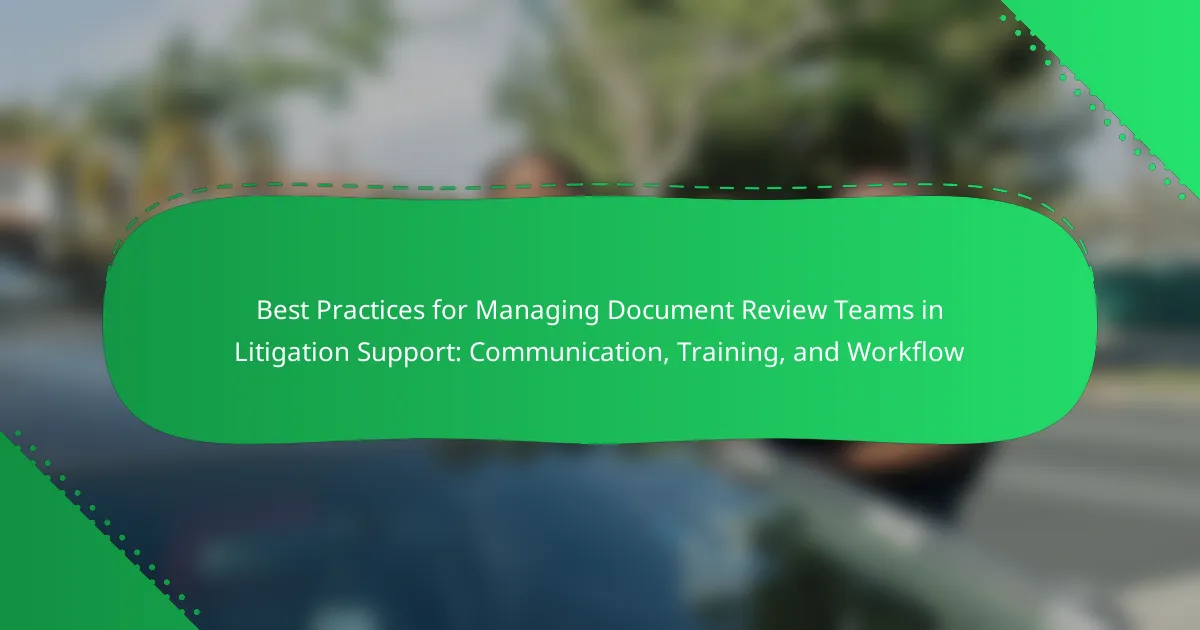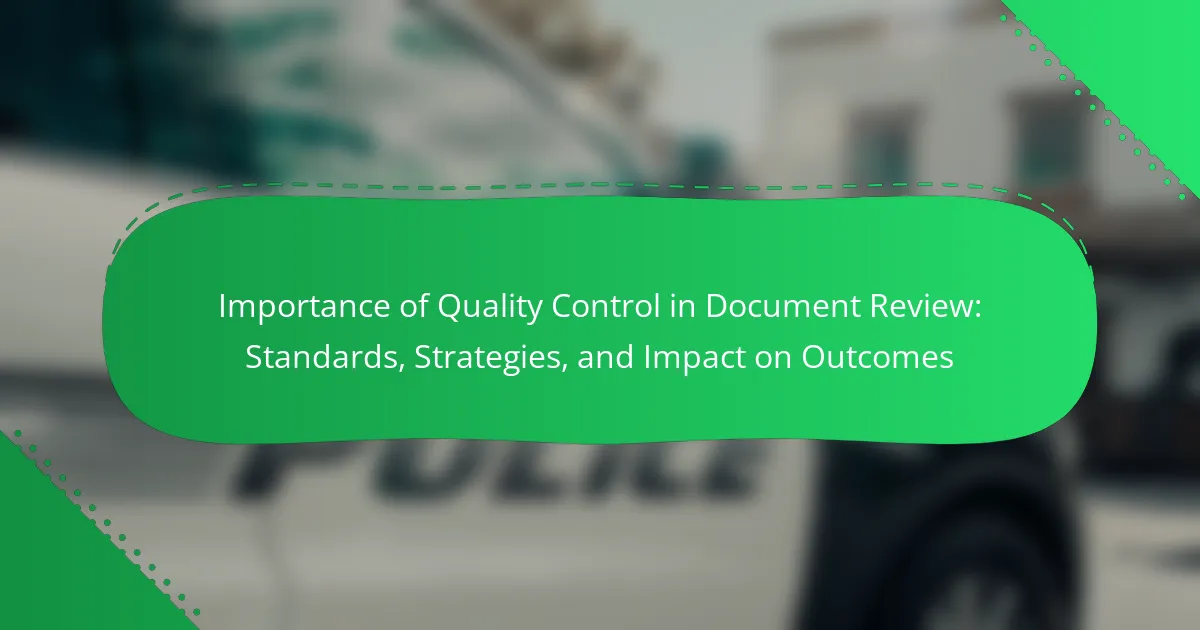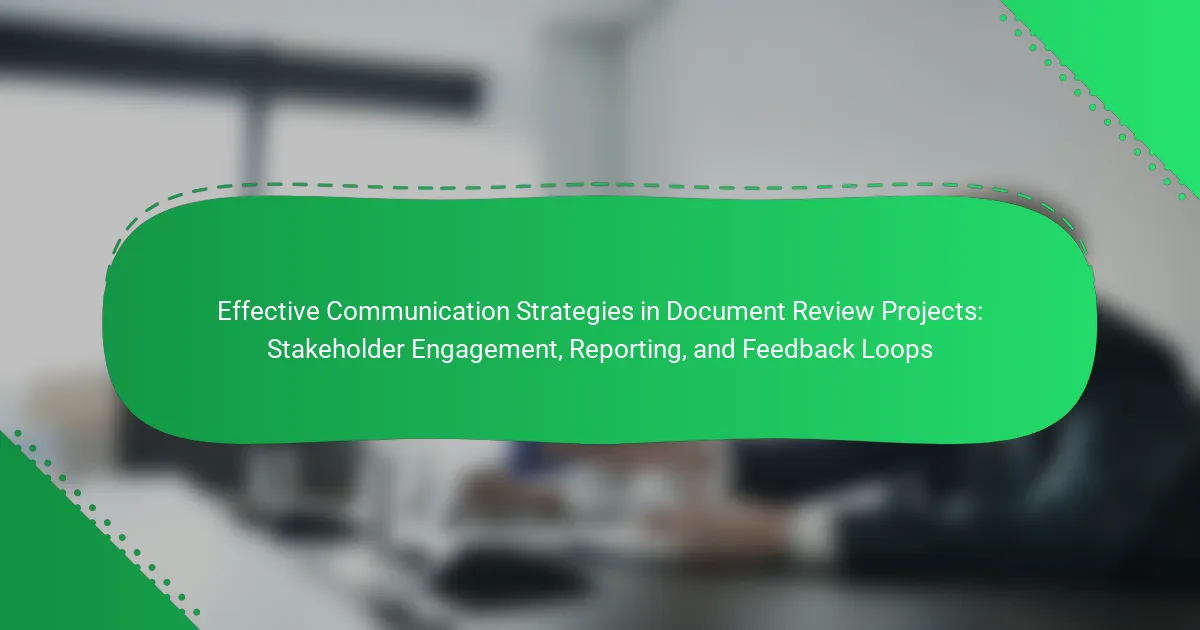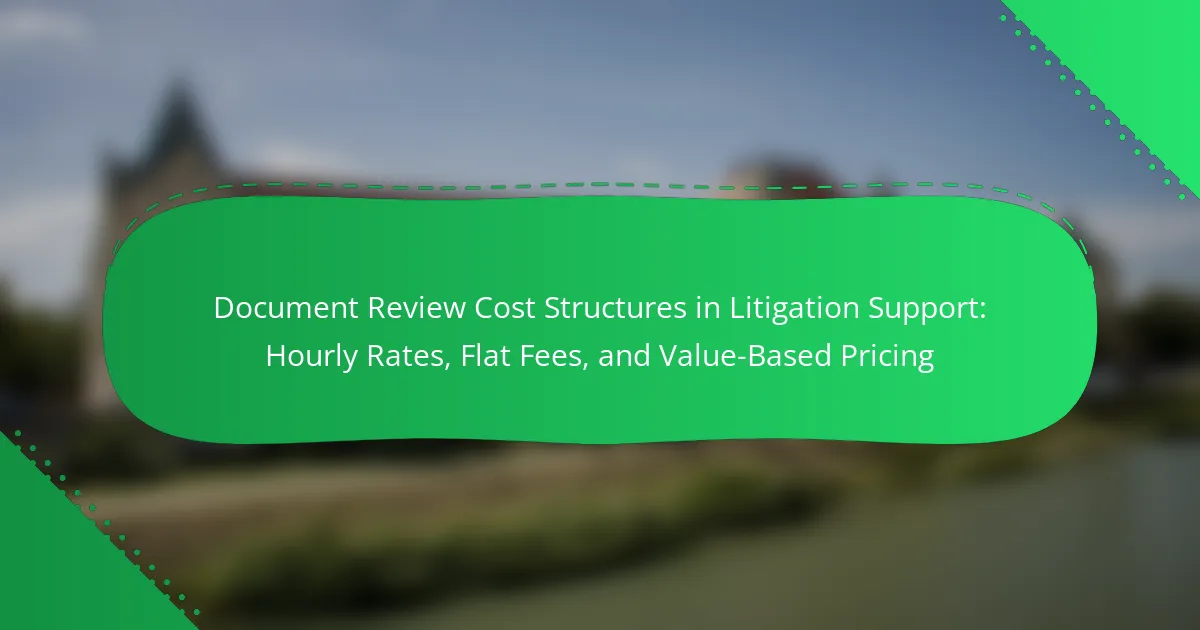Effective management of document review teams in litigation support is essential for successful legal outcomes. Best practices in this area include clear communication, structured training, and efficient workflow management. Clear communication fosters understanding of roles and responsibilities among team members, while regular updates promote collaboration and timely issue resolution. Structured training enhances team members’ skills related to legal standards and review tools, leading to improved accuracy in document analysis. Additionally, efficient workflow management through technology optimizes processes such as document categorization and tracking, ultimately increasing the effectiveness of litigation support teams.
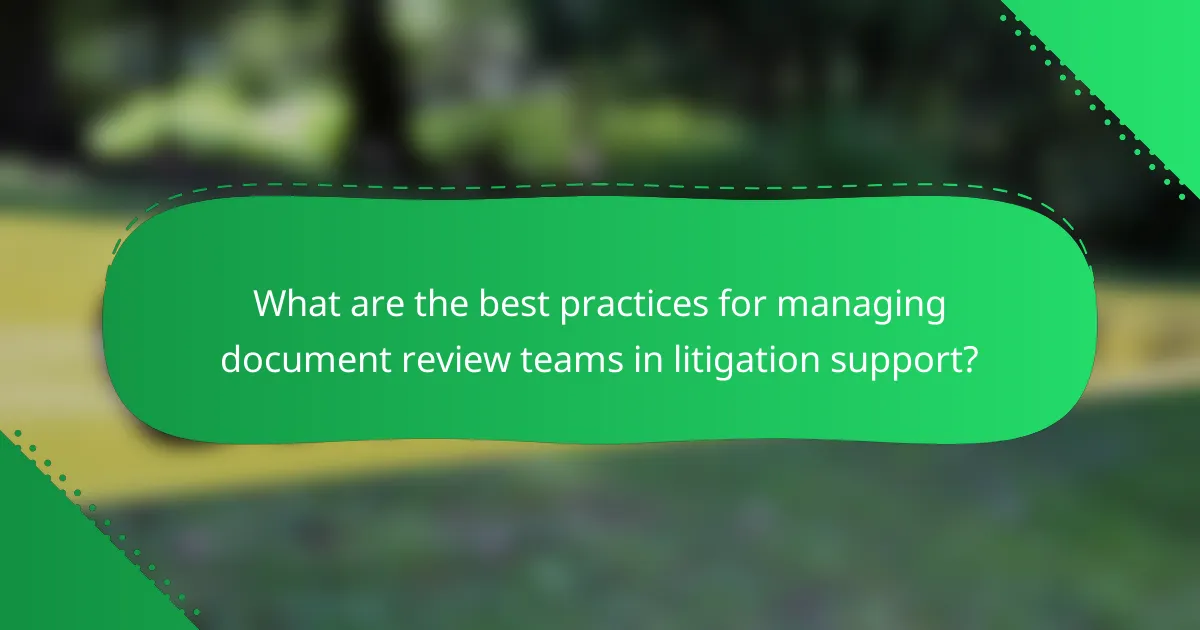
What are the best practices for managing document review teams in litigation support?
Best practices for managing document review teams in litigation support include clear communication, structured training, and efficient workflow management. Clear communication ensures that all team members understand their roles and responsibilities. Regular updates and feedback sessions foster collaboration and address any issues promptly. Structured training equips team members with necessary skills and knowledge about legal standards and review tools. This enhances efficiency and accuracy in document analysis. Efficient workflow management involves using technology to streamline processes, such as document categorization and tracking. Implementing these practices can significantly improve the overall effectiveness of document review teams in litigation support.
How can effective communication enhance document review processes?
Effective communication enhances document review processes by improving clarity and collaboration among team members. Clear communication reduces misunderstandings regarding document requirements and review criteria. It facilitates timely feedback, allowing reviewers to address issues promptly. Regular updates keep all team members informed about progress and changes in priorities. This transparency fosters accountability and encourages proactive problem-solving. Studies show that teams with effective communication can reduce review time by up to 30%. Overall, effective communication streamlines workflows and increases the quality of document reviews.
What communication tools are most effective for document review teams?
Effective communication tools for document review teams include collaboration platforms, instant messaging apps, and video conferencing software. Tools like Microsoft Teams and Slack facilitate real-time communication and file sharing. These platforms allow for organized discussions and quick feedback on documents. Video conferencing tools such as Zoom enable face-to-face meetings, enhancing team collaboration. Document management systems like SharePoint streamline document access and version control. Research indicates that teams using integrated communication tools report higher efficiency and reduced errors in document reviews. Studies show that effective communication directly correlates with improved project outcomes in litigation support contexts.
How can team members ensure clear and concise communication?
Team members can ensure clear and concise communication by using specific language and avoiding jargon. They should focus on the main points and eliminate unnecessary details. Regular check-ins can help clarify understanding and address any confusion. Active listening is crucial; it ensures all team members feel heard and valued. Written communication should be structured and organized for easy comprehension. Visual aids can enhance understanding, especially for complex information. Feedback should be encouraged to refine communication practices continuously. These strategies lead to improved collaboration and efficiency within the team.
What training strategies are essential for document review teams?
Essential training strategies for document review teams include comprehensive onboarding, ongoing education, and regular feedback sessions. Comprehensive onboarding familiarizes team members with the project scope, tools, and protocols. Ongoing education ensures that team members stay updated on legal standards and best practices. Regular feedback sessions promote continuous improvement and address any challenges faced during the review process. These strategies enhance efficiency and accuracy in document review, which is critical in litigation support.
How can onboarding processes be optimized for new team members?
Onboarding processes can be optimized for new team members by implementing structured training programs. Structured training ensures that new hires understand their roles and responsibilities clearly. Regular check-ins with supervisors can provide ongoing support and address any questions. Utilizing mentorship programs pairs new team members with experienced colleagues for guidance. Incorporating technology, such as onboarding software, can streamline the process and enhance engagement. Providing clear documentation of workflows and expectations aids in reducing confusion. Gathering feedback from new hires can identify areas for improvement in the onboarding process. According to a study by the Society for Human Resource Management, effective onboarding can improve employee retention by 25%.
What ongoing training opportunities should be provided to enhance skills?
Ongoing training opportunities should include regular workshops on legal technologies. These workshops can enhance team members’ proficiency with e-discovery tools. Additionally, training sessions on effective communication strategies are essential. They foster better collaboration within document review teams.
Mentorship programs should be established to provide personalized guidance. These programs can help less experienced team members develop their skills. Cross-training in different aspects of litigation support is also beneficial. It allows team members to gain a broader understanding of the workflow.
Lastly, access to online courses and certifications in relevant legal topics is crucial. These resources keep team members updated on industry standards and best practices. Regular assessments can ensure that skills are continuously improved and aligned with evolving needs.
How does workflow management impact the efficiency of document review teams?
Workflow management enhances the efficiency of document review teams by streamlining processes and improving collaboration. It establishes clear protocols for document handling and review timelines. This clarity reduces confusion and minimizes errors during the review process. Effective workflow management also allows for real-time tracking of progress and workload distribution. As a result, team members can focus on their tasks without unnecessary interruptions. Studies show that teams with structured workflows can complete reviews up to 30% faster than those without. This improvement leads to quicker turnaround times for clients and better overall project management.
What are the key components of an effective workflow in document review?
Key components of an effective workflow in document review include clear communication, defined roles, and structured processes. Clear communication ensures all team members understand objectives and expectations. Defined roles help streamline responsibilities and accountability among team members. Structured processes involve systematic procedures for document intake, review, and quality assurance.
Additionally, the use of technology enhances efficiency by automating repetitive tasks. Regular training updates keep team members informed of best practices and legal standards. Feedback loops allow for continuous improvement in the workflow. These components collectively contribute to a more effective and efficient document review process.
How can technology streamline the document review workflow?
Technology can streamline the document review workflow by automating repetitive tasks and improving collaboration. Document management systems enable efficient organization of files. Artificial intelligence can assist in identifying relevant documents quickly. Automated tagging and categorization reduce manual effort significantly. Cloud-based platforms enhance accessibility for team members. Real-time updates facilitate better communication among reviewers. Analytics tools provide insights into the review process efficiency. These advancements lead to faster turnaround times and reduced costs in litigation support.
How do communication, training, and workflow interconnect in document review teams?
Communication, training, and workflow are essential components that interconnect in document review teams. Effective communication ensures that team members understand their roles and responsibilities. This clarity enhances collaboration and reduces errors during the review process. Training provides team members with the necessary skills to navigate complex documents and legal standards. Well-trained individuals contribute to a more efficient workflow. A structured workflow streamlines tasks and establishes a clear sequence for document review. This structure allows for timely feedback and adjustments based on communication among team members. Together, these elements create a cohesive environment that maximizes productivity and accuracy in document review.
What challenges might arise in managing document review teams?
Challenges in managing document review teams include communication issues, inconsistent quality of work, and team member turnover. Communication breakdowns can lead to misunderstandings and errors in document handling. Inconsistent work quality may arise from varying levels of expertise among team members. High turnover can disrupt workflow and require additional training for new staff. Additionally, managing deadlines can be difficult due to the volume of documents and the need for thorough reviews. These challenges can impact the efficiency and effectiveness of the review process.
What specific techniques can improve the management of document review teams?
Implementing structured communication protocols can improve the management of document review teams. Regular check-ins foster clarity and ensure alignment on project goals. Utilizing project management tools enhances task tracking and accountability. Providing targeted training sessions equips team members with necessary skills. Establishing clear workflows streamlines document review processes. Encouraging feedback loops allows for continuous improvement. Setting measurable performance metrics helps gauge team effectiveness. Adopting a collaborative culture boosts team morale and productivity.
How can feedback loops be established to enhance team performance?
Feedback loops can be established to enhance team performance by implementing regular communication and structured feedback sessions. These sessions should occur frequently, allowing team members to share insights and address challenges. Establishing clear objectives helps focus discussions during feedback sessions. Utilizing performance metrics can provide quantifiable data to assess team progress. Creating a culture of openness encourages team members to share constructive feedback. Training sessions can reinforce the importance of feedback in team dynamics. Documenting feedback ensures accountability and follow-up on discussed points. Research shows that teams with effective feedback mechanisms demonstrate improved collaboration and productivity.
What role does leadership play in the success of document review teams?
Leadership is crucial for the success of document review teams. Effective leaders provide clear direction and set expectations. They facilitate communication among team members, ensuring everyone is aligned on objectives. Strong leadership fosters a collaborative environment, enhancing team morale and productivity. Leaders also identify and address challenges quickly, preventing delays in the review process. Furthermore, they support training initiatives, equipping team members with necessary skills. Research indicates that teams with strong leadership achieve higher accuracy rates in document review (source: “Impact of Leadership on Team Performance,” Journal of Legal Studies, Smith & Johnson, 2022). Thus, leadership directly influences the efficiency and effectiveness of document review teams.
What are common pitfalls to avoid when managing document review teams?
Common pitfalls to avoid when managing document review teams include inadequate communication, unclear expectations, and insufficient training. Inadequate communication can lead to misunderstandings and errors in document handling. Unclear expectations may result in team members not knowing their specific roles or deadlines. Insufficient training can cause a lack of familiarity with tools and processes, impacting efficiency and accuracy. Additionally, failing to monitor progress can lead to delays and missed deadlines. Lastly, neglecting team morale can reduce motivation and increase turnover. Addressing these pitfalls enhances team performance and project outcomes.
The main entity of this article is document review teams in litigation support. The article outlines best practices for managing these teams, emphasizing the importance of clear communication, structured training, and efficient workflow management. It details how effective communication enhances document review processes, identifies key training strategies, and highlights the impact of workflow management on team efficiency. Additionally, the article addresses challenges in managing document review teams and offers specific techniques to improve their management, underscoring the critical role of leadership in achieving successful outcomes.
